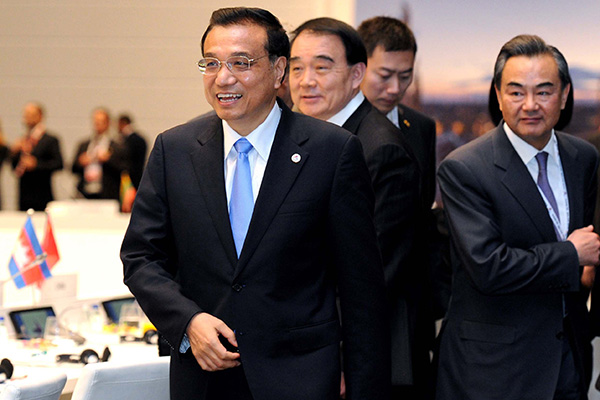
Premier Li Keqiang attends the closing ceremony of the Asia-Europe Meeting in Milan, Italy, on Oct 17. [Photo by Rao Aimin/Xinhua]
Premier’s initiative aimed at tackling a range of challenges on continents
Premier Li Keqiang has put forward a blueprint for cooperation between Asia and Europe, voicing China’s commitment to boosting interconnectivity and shouldering more duties in global governance and security.
Observers said he has submitted the bold initiative as a recipe for dealing with a range of political, economic and social challenges facing both continents.
At the 10th Asia-Europe Meeting summit held in Milan, Italy, on Oct 16 and Oct 17, Li called for Asian and European countries to safeguard peace and security and boost interconnectivity to promote development of the world’s largest landmass.
The ASEM is a high-level, large-scale intergovernmental platform for dialogue and cooperation between the two continents.
China is ready to work with other countries to foster awareness of a “Eurasian community” and to promote unity and coordination between Asia and Europe, Li said.
It is also willing to work with other countries to build a Eurasian infrastructure network, Li said on Oct 16.
Cui Hongjian, director of the Department for European Studies at the China Institute of International Studies, said, “The ASEM summit has offered a good opportunity to bring the Silk Road Economic Belt and the 21st Century Maritime Silk Road concepts into Asia-Europe cooperation.”
Cui was referring to the two transcontinental initiatives proposed by China last year.
Wang Xuexian, China’s former deputy permanent representative to the United Nations, said Beijing’s connectivity initiatives have attracted support from many countries, including Russia and Italy.
Li’s proposals at the summit are “hugely feasible” because concrete measures and advice have been given, Wang said.
Li urged Asian and European countries to safeguard regional peace, security and development. He also encouraged them to improve interconnectivity and to further liberalize trade and investment.
He proposed resuming the ASEM Economic Ministers’ Meeting mechanism and setting up a Eurasian center for cooperation on scientific and technological innovation.
Li also reiterated China’s adherence to the policy of peaceful development, good neighborliness and friendship.
“We will handle disputes in a reasonable and practical manner, become stakeholders of neighboring Asian countries and have a common destiny in sharing responsibilities,” Li said in an address to the plenary session of the ASEM on Oct 16.
In a session on Oct 17, he said “the peace and stability of the continent matters to world peace and security”, and called on all the countries to jointly safeguard “the fruits” of World War II.
Turning to global cooperation in the fight against the Ebola outbreak, Li said China will provide additional aid worth at least 100 million yuan ($16 million) to help combat the outbreak in West Africa.
China had previously offered Africa 234 million yuan in aid to battle the disease.
BACKGROUND
What is ASEM?
The Asia-Europe Meeting is an intergovernmental forum between Asia and Europe. Launched in 1996, the biennial summit has served as a venue for dialogue between Asian and European countries.
How does it work?
The dialogue addresses issues concerning ASEM’s three pillars (political, economical, social-cultural-educational) and serves as the highest level of decisionmaking in the ASEM process. Its membership of 51 nations plus the European Commission and ASEAN Secretariat will soon expand to 53 nations after the expected accession of Kazakhstan and Croatia at this summit.
The role of ASEM
The following joint statement from Herman Van Rompuy, president of the European Council, and Jose Manuel Barroso, president of the European Commission, in a signed article published on China Daily earlier this week, may best explain the role of ASEM: “Asia matters-for Europe. And Europe matters-for Asia. That is why the Asia-Europe Meeting was created in 1996. That is why it has become the key forum for dialogue and cooperation between Europe and Asia.”
